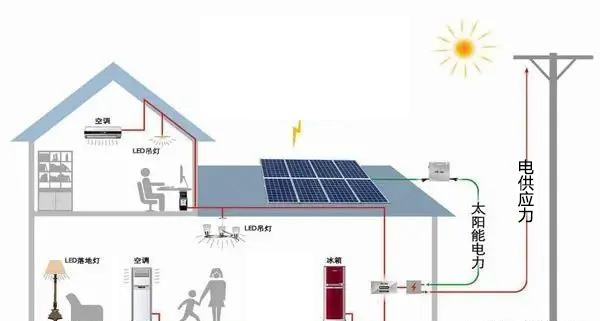What is photovoltaic power generation?
Photovoltaic power generation refers to a power generation method that uses solar radiation to directly convert into electrical energy.
What is distributed solar power?
Distributed photovoltaic power generation refers to equipment built near the user’s site. The operation mode is mainly based on self-generation and self-use by the user, and the excess electricity is connected to the grid. It is a photovoltaic power generation facility characterized by balanced regulation of the distribution system.
Why is photovoltaic power considered a green and low-carbon energy?
Photovoltaic power generation has significant energy, environmental protection and economic benefits. It is one of the highest quality green energy sources. If a 1 kilowatt photovoltaic power generation system is installed under China’s average sunshine conditions, it can generate 1,200 kilowatt hours of electricity in one year, which can reduce coal (standard coal) The usage amount is about 400 kilograms, reducing carbon dioxide emissions by about 1 ton. According to the research results of the World Wildlife Fund (WWF):
In terms of the effect of reducing carbon dioxide, installing a 1 square meter photovoltaic power generation system is equivalent to planting 100 square meters of trees. Currently, the development of renewable energy sources such as photovoltaic power generation is one of the effective means to fundamentally solve environmental problems such as haze and acid rain.
How much sunlight do we have available to us? Could it become the dominant energy source of the future?
The solar radiation received by the earth’s surface can meet 10,000 times the global energy demand. The average annual radiation received by each square meter of the earth’s surface varies from region to region, ranging from 1,000 to 2,000 KWH. According to data from the International Energy Agency, installing solar photovoltaic systems on 4% of the world’s deserts is enough to meet global energy demand. Solar photovoltaics enjoy a broad development space and its potential is enormous.
Which locations are suitable for installing distributed photovoltaic power generation systems?
1
Industrial factory buildings
In factories with high electricity consumption and high online electricity bills, the factory roofs are usually large and flat, which are suitable for installing photovoltaic arrays. In addition, due to the large electricity load, the distributed photovoltaic grid-connected system can be used for local consumption, offsetting part of the online electricity consumption, thereby saving electricity bills.
2
Commercial buildings
Similar to the effect of industrial parks, the difference is that commercial buildings are mostly cement roofs, which are more conducive to the installation of photovoltaic arrays. However, there are often requirements for the aesthetics of the building, according to the characteristics of commercial buildings, office buildings, carports, hotels, conference centers, resorts and other building categories. The user load characteristics are generally higher during the day and lower at night, which can better match the characteristics of photovoltaic power generation.
3
Agricultural facilities
There are a large number of available roofs in rural areas, including self-owned houses, vegetable greenhouses, fish ponds, etc., which are often at the end of the public power grid and have poor power quality. Building distributed photovoltaic systems in rural areas can improve power security and power quality.
4
Remote agricultural and pastoral areas and islands
Distributed power generation systems are very suitable for places far away from the national power grid.
Post time: Aug-01-2024


